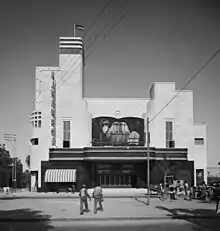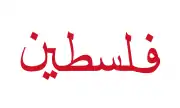 | |
| Use | National flag |
|---|---|
| Proportion | 1:2 |
| Adopted | 28 May 1964 (PLO) 15 November 1988 (State of Palestine) |
| Design | A horizontal tricolour of black, white, and green; with a red triangle based at the hoist |
.svg.png.webp) | |
| Use | Presidential standard[1] |
| Proportion | 1:2 |
| Design | A horizontal tricolour of black, white, and green; with a red triangle based at the hoist charged with the national emblem above two crossed white swords in the upper hoist corner |
The flag of Palestine (Arabic: علم فلسطين, romanized: ʿalam Filasṭīn) is a tricolor of three equal horizontal stripes (black, white, and green from top to bottom) overlaid by a red triangle issuing from the hoist. This flag is derived from the Pan-Arab colors and is used to represent the State of Palestine and the Palestinian people.
The Palestinian flag in its current form has been used in Palestine at least since the late 1930s. It was officially adopted as the flag of the Palestinian people by the Palestine Liberation Organization (PLO) in 1964. The flag day is celebrated on 30 September.[2]
The flag is similar to that of Syria's Ba'ath Party, which uses the same shapes and colours but a 2:3 ratio as opposed to Palestine's 1:2, as well as the short-lived Arab Federation of Iraq and Jordan (which had an equilateral triangle at the hoist). It is also very similar to the Flag of Jordan and to the Flag of Western Sahara, all of which draw their inspiration from the Great Arab Revolt against Ottoman rule (1916–1918). The flag of the Arab Revolt had the same graphic form, but the colours were arranged differently (white on the bottom, rather than in the middle).
In 2021, President Mahmoud Abbas approved the annual lowering of the flag to lament the Balfour Declaration.[3]
Origin

| Part of a series on |
| Palestinians |
|---|
 |
| Demographics |
| Politics |
|
| Religion / religious sites |
| Culture |
| List of Palestinians |
The flag used by the Arab Palestinian nationalists in the first half of the 20th century is the flag of the 1916 Arab Revolt. The origins of the flag are the subject of dispute and mythology. In one version, the colours were chosen by the Arab nationalist 'Literary Club' in Istanbul in 1909, based on the words of the 13th-century Arab poet Safi al-Din al-Hili:
Ask the high rising spears, of our aspirations
Bring witness the swords, did we lose hope
We are a band, honor halts our souls
Of beginning with harm, those who won't harm us
White are our deeds, black are our battles,
Green are our fields, red are our swords.
Another version credits the Young Arab Society, which was formed in Paris in 1911. Yet another version is that the flag was designed by Sir Mark Sykes of the British Foreign Office. Whatever the correct story, the flag was used by Sharif Hussein by 1917 at the latest and quickly became regarded as the flag of the Arab national movement in the Mashriq.[4][5]
On 18 October 1948, the flag of the Arab Revolt was adopted by the All-Palestine Government, and was recognised subsequently by the Arab League as the flag of Palestine. A modified version (changing the order of stripes) has been used in Palestine at least since the late 1930s and was officially adopted as the flag of the Palestinian people by the Palestine Liberation Organization (PLO) in 1964. On 1 December of the same year, the Executive Committee of the Liberation Organization established a special system for the flag specifying its standards and dimensions, and the black and green colors replaced each other.[6] On 15 November 1988, the PLO adopted the flag as the flag of the State of Palestine.[6]
On the ground the flag became widely used since the Oslo Agreements, with the establishment of the Palestinian Authority in 1993. Today the flag is flown widely by Palestinians and their supporters.[7][8][9]
Bans in Israel

In 1967, immediately following the Six-Day War, the State of Israel banned the Palestinian flag in the occupied Gaza Strip and West Bank. A 1980 law forbidding artwork of "political significance" banned artwork composed of its four colours, and Palestinians were arrested for displaying such artwork.[10][11][12]
The ban was lifted after the signing of the Oslo Peace Accords in 1993.[13] Since 2014, Israeli police have had the authority to confiscate a flag if it is used in support of terrorism or disrupts public order,[13] and Palestinian flags are routinely confiscated by the police.[14] In January 2023, Minister of National Security Itamar Ben-Gvir announced he had instructed the police to ban the flag's showcasing in public spaces.[15][13]
Historical flags

 Flag used during the 1936–1939 Arab revolt
Flag used during the 1936–1939 Arab revolt
.svg.png.webp)
 Flag used by the All-Palestine Government, the Flag of the Arab Revolt (with the changed order of colours the flag received in 1920)
Flag used by the All-Palestine Government, the Flag of the Arab Revolt (with the changed order of colours the flag received in 1920).svg.png.webp)
 Flag from 1948 to 1964
Flag from 1948 to 1964
 Version with shorter triangle, used by the Palestine Liberation Organization until the 1980s
Version with shorter triangle, used by the Palestine Liberation Organization until the 1980s
 Flag used in some period of its history
Flag used in some period of its history
Construction Sheet
.svg.png.webp) flag construction sheet
flag construction sheet
Color scheme
Colors scheme |
Red | Black | White | Green |
|---|---|---|---|---|
| CMYK | 0-82-77-6 | 100-100-100-99 | 0-0-0-0 | 100-0-64-40 |
| HEX | #EE2A35 | #000000 | #FFFFFF | #009736 |
| RGB | 238-42-53 | 0-0-0 | 255-255-255 | 0-151-54 |
See also
Notes
- ↑ Breschi, Roberto. "PALESTINA - Bandiera del presidente". Bandiere - Passato e Presente (in Italian). Retrieved 31 July 2019.
- ↑ "Palestinians celebrate Flag Day marking two years since hoisting it at UN". WAFA Agency.
- ↑ "Palestinian flag to be flown at half mast to mourn Balfour Declaration". The Jerusalem Post | Jpost.com.
- ↑ Sorek, Tamir (2004). "The orange and the 'Cross in the Crescent': imagining Palestine in 1929". Nations and Nationalism. 10 (3): 269–291. doi:10.1111/j.1354-5078.2004.00167.x.
- ↑ Easterly, William (2006). The White Man's Burden. New York: Penguin. p. 238. ISBN 978-1-1012-1812-9.
A small sign of the artificiality of the Arab revolt is that Mark Sykes himself designed the flag of the Arabs as a combination of green, red, black, and white. Variations on this design are today the official flags of Jordan, Iraq, Syria, and the Palestinians.
- 1 2 "العلم | مركز المعلومات الوطني الفلسطيني". info.wafa.ps.
- ↑ "United Nations Security Council: The situation in the Middle East, including the Palestinian question". 2 June 2008. Archived from the original on 2 June 2008. Retrieved 20 May 2017.)
Mr. Terje Roed-Larsen, Special Coordinator for the Middle East Peace Process and Personal Representative of the Secretary-General: "[Arafat] with the trademark kaffiyeh epitomized Palestinian identity and national aspirations, even more than the Palestinian flag or the national anthem." - ↑ "Palestine". Flags of the World.
The Palestinian flag represents all Palestinian Arab aspirations regardless of party.
- ↑ Efaw, Jamie. "Palestinian Psychological Operations: The First Intifada]". AmericanDiplomacy.org.
An example of a common, obvious symbolism came in the form of the Palestinian flag. [...] the flag and the colors transmitted the message to all target audiences the underlying theme of the entire Intifada—Palestinian nationalism. The flag, the symbol of Palestinian nationalism, was ubiquitous in the occupied territories.
- ↑ Kifner, John (16 October 1993). "Ramallah Journal; A Palestinian Version of the Judgment of Solomon". The New York Times. Retrieved 21 May 2010.
- ↑ Dalrymple, William (2 October 2002). "A culture under fire". The Guardian. London. Retrieved 21 May 2010.
- ↑ "The watermelon makes a colourful interlude". The Age. Melbourne. 12 September 2004.
- 1 2 3 Kellman, Laurie (9 January 2023). "Palestinian prime minister says Israel aims to topple the PA". The Washington Post. Washington, D.C. Retrieved 9 January 2023.
- ↑ "The Palestinian flag: A target for 'erasure' by Israeli forces".
- ↑ "Israel security minister bans Palestinian flag-flying in public". The Guardian. London. 9 January 2023. Retrieved 9 January 2023.
- ↑ Breschi, Roberto. "Palestina". www.rbvex.it. Retrieved 25 July 2019.
